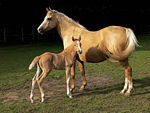Equidae
| Equids Fossil range: 54–0 Ma Early Eocene to Recent |
||||||||||||
|---|---|---|---|---|---|---|---|---|---|---|---|---|
 Plains Zebras
|
||||||||||||
| Scientific classification | ||||||||||||
|
||||||||||||
| Species | ||||||||||||
|
E. asinus - Donkey |
Equidae is the family of horse-like animals, which belong to the order Perissodactyla. It is sometimes known as the horse family. Apart from the horse, other extant equids include assorted subspecies of donkey or ass, and the zebras. All of these are in the genus Equus.
Contents |
Characteristics
- See also: Horse anatomy and Horse behavior
Equids are medium to large mammals, with long heads, and necks with a mane. Their legs are slender and end in a single, unguligrade toe, protected by a horny hoof. They have long, slender, tails, either ending in a tuft, or entirely covered in flowing hair. They are adapted to generally open terrain, from plains and savannas, to mountains or deserts.
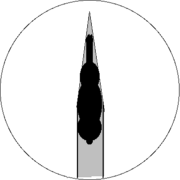
The pinnae ("ears") of equids are mobile, enabling them to easily localise the origin of sounds. They have two-color, or dichromatic vision. Their eyes are set back far on the head, giving them a wide angle of view, without entirely losing binocular vision. Equids also have a vomeronasal organ, that allows males to use the flehmen, or 'lip-curling' response to assess the sexual state of potential mates.
Equids are herbivores, and feed predominantly on tough, fibrous food, such as grasses and sedges. When in need, they will also eat other vegetable matter, such as leaves, fruits, or bark, but are normally grazers, not browsers. Unlike ruminants, with their complex stomachs, equids break down cellulose in the "hindgut" or cecum, a part of the colon. Their dentition is almost complete, with cutting incisors to crop food, and grinding molars set well back behind a diastema. The dental formula for equids is:
| 3.1.3-4.3 |
| 3.1.3.3 |

Equids are social animals, living in herds or bands. Horses, along with Plains and Mountain Zebras, have permanent herds generally consisting of a single male and a band of females, with the remaining males forming small "bachelor" herds. The remaining species have temporary herds, lasting only a few months, which may be either single-sexed or mixed. In either case, there are clear hierarchies established amongst the individuals, usually with a dominant female controlling access to food and water resources and the lead male controlling mating opportunities.
Females, usually called mares in horses and zebras, or, in the case of asses and donkeys, jennys, usually bear a single foal, after a gestation period of approximately 11 months. Young equids are able to walk within an hour of birth, and are weaned after four to thirteen months (animals living in the wild naturally wean foals at a later date than those under domestication). Depending on species, living conditions and other factors, females in the wild may give birth every year or every other year.[1][2]
Equids who are not in foal generally have a seasonal estrous cycle, from early spring into autumn. Most females enter an anestrus period during the winter and thus do not cycle in this period. The reproductive cycle is controlled by the photoperiod (length of the day), with estrus triggered when the days begin to lengthen. Anestrus prevents the female from conceiving in the winter months, as that would result in her foaling during the harshest part of the year, a time when it would be more difficult for the foal to survive.[3] However, equids who live near the equator, where there is less change in length of day from season to season, have no anestrus period, at least in theory.[4] Further, for reasons that are not clear, about twenty percent of domestic mares in the Northern Hemisphere will cycle the year round.[5]
Evolution

The oldest known equid fossils date from the early Eocene, 54 million years ago. This species, Hyracotherium (formerly known as Eohippus), was a fox-sized animal with three toes on its hind feet, and four on the front feet. It was herbivorous browser on relatively soft plants, and already adapted for running. The complexity of its brain suggests that it was already an alert and intelligent animal.[6] Later species reduced the number of toes, and developed teeth more suited for grinding up grasses and other tough plant food.
The group became relatively large during the Miocene, with many new species appearing. By this time, equids were more truly horse-like, having developed the typical body shape of the modern animals. Many of these species bore the main weight of their bodies on their central, third, toe, with the others becoming reduced, and barely touching the ground, if at all. The surviving modern genus, Equus, had evolved by the early Pleistocene, and spread rapidly though the world.[7]
Classification
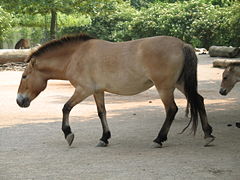
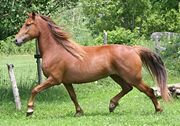
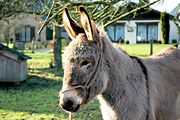
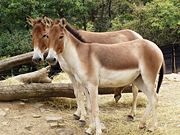
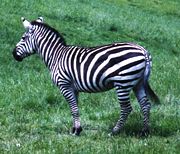
- Order Perissodactyla (In addition to Equidae, Perissodactyla includes four species of tapir in a single genus, as well as five living species (belonging to four genera) of rhinoceros.) † indicates extinct species.
- Family Equidae
- Genus Hyracotherium†
- Genus Orohippus†
- Genus Epihippus†
- Genus Haplohippus†
- Genus Mesohippus†
- Genus Miohippus†
- Genus Archaeohippus†
- Genus Anchitherium†
- Genus Kalobatippus†
- Genus Hypohippus†
- Genus Sinohippus†
- Genus Megahippus†
- Genus Parahippus†
- Genus Merychippus†
- Genus Acritohippus†
- Genus Pseudhipparion†
- Genus Nannippus†
- Genus Neohipparion†
- Genus Hipparion†
- Genus Proboscidipparion†
- Genus Stylohipparion†
- Genus Cormohipparion†
- Genus Protohippus†
- Genus Parapliohippus†
- Genus Heteropliohippus†
- Genus Pliohippus†
- Genus Calippus†
- Genus Astrohippus†
- Genus Hippidion†
- Genus Onohippidium†
- Genus Dinohippus†
- Genus Equus
- Subgenus Equus
- Horse, Equus caballus
- Wild Horse, Equus ferus
- †Tarpan, Equus ferus ferus
- Przewalski's Horse or Mongolian Wild Horse, Equus ferus przewalskii
- †Yukon Horse, Equus lambei
- Subgenus Asinus
- African Wild Ass, Equus africanus
- Nubian Wild Ass, Equus africanus africanus
- †Atlas Wild Ass, Equus africanus atlanticus
- Somali Wild Ass, Equus africanus somalicus
- Donkey or Burro, Equus africanus asinus
- †European Ass, Equus hydruntinus
- Onager or Asiatic Ass, Equus hemionus, Equus hemionus onager
- Mongolian Wild Ass, Equus hemionus hemionus
- †Syrian Wild Ass, Equus hemionus hemippus
- Gobi Kulan or Dziggetai , Equus hemionus luteus
- Turkmenian Kulan, Equus hemionus kulan
- Indian Wild Ass or Khur, Equus hemionus khur
- Kiang, Equus kiang
- Western Kiang, Equus kiang kiang
- Eastern Kiang, Equus kiang holdereri
- Southern Kiang, Equus kiang polyodon
- Northern Kiang, Equus kiang chu
- †Cummin’s Ass, Equus cumminsii
- †Stilt-legged Onager, Equus calobatus
- †Pygmy Onager, Equus tau
- African Wild Ass, Equus africanus
- Subgenus Dolichohippus
- Grevy's Zebra, Equus grevyi
- Subgenus Hippotigris
- Plains Zebra, Equus quagga
- †Quagga, Equus quagga quagga
- Burchell's Zebra, Equus quagga burchellii
- Grant's Zebra, Equus quagga boehmi
- Selous' zebra, Equus quagga borensis
- Chapman's Zebra, Equus quagga chapmani
- Crawshay's Zebra, Equus quagga crawshayi
- Mountain Zebra, Equus zebra
- Cape Mountain Zebra, Equus zebra zebra
- Hartmann's Mountain Zebra, Equus zebra hartmannae
- Plains Zebra, Equus quagga
- †Subgenus Amerhippus
- †Scott’s Horse, Equus scotti
- †Niobrara Horse, Equus niobrarensis
- †Mexican Horse, Equus conversidens
- †Subgenus Parastylidequus
- †Mooser’s Horse, Equus parastylidens
- incertae sedis
- †Hagerman Horse (or Hagerman Zebra), Equus simplicidens - perhaps closest to Dolichohippus[8]
- †Western Horse, Equus occidentalis
- †Complex-toothed Horse, Equus complicatus
- †Brother Horse, Equus fraternus
- †Noble Horse, Equus excelsus - subgenus Equus?
- †'Giant' Horses, Equus giganteus group
- † Equus giganteus
- † Equus pacificus
- † Equus pectinatus
- † Equus crinidens
- Subgenus Equus
- Family Equidae
Cross-breeds
Different species of equidae can crossbreed, though the ensuing offspring are usually infertile. Some hybrid equidae include:
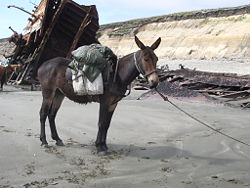
- Mule, a cross between a male donkey and a female horse. Mules are the most common type of hybrid equid and are renowned for their toughness, surefootedness, and working ability.
- Hinny, a cross between a female donkey and a male horse. Considered a less desirable cross than a mule, generally smaller in size and not as hardy.
- Zeedonk or Zonkey, a cross between a donkey and a zebra.
- Zony, a zebra/pony cross.
- Zorse or zebrula, the offspring of a zebra stallion and a horse mare; the rarer reverse pairing is sometimes called a hebra.
Any equid with partial zebra ancestry is also called a zebroid.
See also
References
- ↑ Macdonald, D., ed. (1984). The Encyclopedia of Mammals. New York: Facts on File. pp. 482–485. ISBN 0-87196-871-1.
- ↑ "ENVIRONMENTAL ASSESSMENT: PRYOR MOUNTAIN WILD HORSE RANGE FY2004: FERTILITY CONTROL ON AGE-SPECIFIC WILD HORSE MARES." BLM National Research Field Trials on Wild Horse Fertility Control, Summer 2004 Web page accessed November 21, 2007
- ↑ Ensminger, M. E. Horses and Horsemanship: Animal Agriculture Series. Sixth Edition. Interstate Publishers, 1990. ISBN 0-8134-2883-1 p. 156
- ↑ Eilts, Bruce E. "Aberrations of the Equine Estrous cycle," Louisians State University school of Veterinary Medicine, last modified 15 August 2007. Web page accessed November 21, 2007
- ↑ Id.
- ↑ Palmer, D., ed. (1999). The Marshall Illustrated Encyclopedia of Dinosaurs and Prehistoric Animals. London: Marshall Editions. pp. 255. ISBN 1-84028-152-9.
- ↑ Savage, RJG, & Long, MR (1986). Mammal Evolution: an illustrated guide. New York: Facts on File. pp. 200–204. ISBN 0-8160-1194-X.
- ↑ Hagerman Fossil Beds NM Hourse Quarry Page
Sources
- Burke, et al. 2003. The systematic position of Equus hydruntinus, an extinct species of Pleistocene equid. Quaternary Research 59(3):459-469.
- Duncan, P. (ed.). 1992. Zebras, Asses, and Horses: an Action Plan for the Conservation of Wild Equids. IUCN/SSC Equid Specialist Group. IUCN, Gland, Switzerland.
- Equid Specialist Group 1996. Equus ferus. In: IUCN 2004. 2004 IUCN Red List of Threatened Species. <www.iucnredlist.org>. Downloaded on 21 January 2006.
- Equid Specialist Group 1996. Equus ferus ssp. przewalskii. In: IUCN 2004. 2004 IUCN Red List of Threatened Species. <www.iucnredlist.org>. Downloaded on 21 January 2006.
- Groves, C.P. & Bell, H.B. 2004. New investigations on the taxonomy of the zebras genus Equus, subgenus Hippotigris. Mammalian Biology. 69: 182-196.
- Higuchi et al. 1987. Mitochondrial DNA of the Extinct Quagga: Relatedness and Extent of Postmortem Change. Journal of Molecular Evolution 25:283-287.
- International Commission on Zoological Nomenclature. 2003. Opinion 2027 (Case 3010). Usage of 17 specific names based on wild species which are pre-dated by or contemporary with those based on domestic animals (Lepidoptera, Osteichthyes, Mammalia): conserved. Bull.Zool.Nomencl., 60:81-84.
- Moehlman, P.D. 2002. Equids. Zebras, Assess and Horses. Status Survey and Conservation Action Plan. IUCN/SSC Equid Specialist Group. IUCN, Gland, Switzerland. (http://www.iucn.org/themes/ssc/publications/actionplans.htm#Equids2002)
- Orlando, et al. 2006. Geographic distribution of an extinct equid (Equus hydruntinus : Mammalia, Equidae) revealed by morphological and genetical analyses of fossils. Molecular Ecology 15(8):2083-2093.
|
||||||||||||||||||||||||||||||||||||||||||
|
||||||||||||||||||||
